Evaluation of the Economic Convenience Deriving from Reforestation Actions to Reduce Soil Erosion and Safeguard Ecosystem Services in an Apulian River Basin
Abstract
1. Introduction
- All European soils are healthy with enhanced resilience, and are able to continue providing their fundamental services (ESs);
- Net land consumption ceases, and soil pollution returns to levels that do no damage to human health or ecosystems;
- The protection and management of soils is performed sustainably, including the restoration of soils which at present are degraded.
- The Soil Strategy document also includes a set of fixed points and actions for implementation in the future, among which are the following:
- A European law concerning protection of soil health, incorporating the entire strategy;
- Sustainable soil management, i.e., a European practice for soil management, promoted via some specific actions of the Common Agricultural Policy, in order to share and develop the best management practices for agriculture, with campaigns providing free analysis of agricultural soil;
- Encouraging organic carbon accumulation in soils to alleviate the impacts of climate change, also via legislation to protect and constrain wetlands and organic soils;
- Action to prevent desertification by developing a common methodology for the evaluation of its level and the prevention of land degradation (EU Soil Strategy for 2030) [28].
2. Materials and Methods
2.1. Study Area
- Scenario 1: Areas with high erosion (>10 t/ha/year, 284 ha) with the addition of buffer areas of 48 m width. Total afforestation area = 3500 ha (Figure A1, Appendix A).
- Scenario 2: Areas with medium erosion (1.4–10 t/ha/year) cultivated as cereal crops, no less than 150 m from river networks and with an area between 1.00 and 20.00 ha (according to the current regulations). Total afforestation area = 3500 ha (Figure A2, Appendix A).
- -
- Criterion 2: Presence of cereal crops and therefore low-yield crops (which means low monetary value).
- -
- Criterion 3: Distance of at least 150 m from river networks.
- -
- Criterion 4: Single intervention area between 1.00 and 20.00 ha. Total reforestation area = 3500 ha (Figure A2, Appendix A).
2.2. Determination of Soil Loss
- -
- The Borselli K Parameter is a calibration parameter that determines the relationship between hydrological connectivity (the degree of connection between plots of land and watercourses) and nutrient input (the percentage of nutrients that actually reach the watercourse);
- -
- The Borselli IC0 Parameter is an empirical parameter that represents the threshold value of hydrological connectivity beyond which an area is hydrologically connected to the flow network.
2.3. Identification of Ecosystem Services Correlated to Soil Erosion
2.4. Application of Monetary Evaluation for Ecosystem Services Linked to Erosion
- Loss of carbon (regulating services):
- -
- Organic carbon inside the soil (t/ha) from Acla 2 [39] project: A total of 23 profiles of soil horizons of the basin uniformly distributed were examined, in which the values of the organic carbon content detected over time were used. The data were interpolated in a GIS environment, from which the average value/ha of organic C content was obtained.
- -
- Organic carbon present in forest plant components from the Forest Inventory of Puglia Region [46], with particular attention to the above-ground biomass of forest stands (divided into living biomass of adult individuals, shrubs, regeneration, large and fine necromass) and underground biomass (stumps).
- -
- Organic carbon (Mg/ha) present in the permanent agricultural crops most representative of the area of interest (vines, olives, citrus fruits and other fruit trees) as reported by [47,48,49,50,51]. The transformation of C (kg) into CO2 was carried out with the application of the stoichiometric ratio resulting from the oxidative process of 12 kg of carbon, therefore equal to 3.66 (12 kg of C + 32 kg of O2 = 44 kg of CO2) [49], except for Actinidia and apples, where the data expressed in CO2 were already detected and published [50] for the year 2025, which were used and compared with the average data for the last 52 weeks, namely from February 2025 backward = EUR 71.15 + EUR 68.35 (average 69.73 EUR/t CO2) [51].
- Economic assessment of habitat quality (supporting functions):
- Crop productivity (provisioning services):
- Sustainable tourism suitability (cultural ecosystem services):
2.5. Application of the Replacement Cost Method
3. Results
3.1. Determination of Soil Loss at the Basin Scale
- Scenario 1 and Scenario 2 both contribute significantly to reducing soil erosion, despite having very different site conditions, such as the degree of erosion, vegetation cover and slopes. The variation in soil erosion severity at the basin scale could, therefore, depend on geomorphological, climatic and anthropogenic factors, not strictly linked to a specific study area but also to the effects of surrounding areas.
- For the same intervention surface area, the reforestation action carried out on soils covered for only a few months/year (Scenario 2) is equally effective compared to others permanently covered by vegetation.
3.2. Assessment and Economic Evaluation of Ecosystem Services at the Basin Scale
- ▪
- The physical value of carbon sequestered (CO2 t/ha), and therefore not lost due to soil erosion, varies from an average of 30.68 for the current situation (Scenario 0) to 33.64 for Scenario 1 and 34.76 for Scenario 2 (Table 9). The corresponding economic value ranges from 2139.31 EUR/ha for Scenario 0 to 2345.87 EUR/ha for Scenario 1 and 2423.88 EUR/ha for Scenario 2 (Table 10). This confirms that both afforestation Scenario 1 and Scenario 2 determine a reduction in the value of lost soil, and therefore an increase in its economic value.Specifically, the regulation service increases by 0.38 tons/ha in Scenario 1 and by 0.48 tons/ha in Scenario 2, due to the action of the root systems of broadleaf forest species, which act directly by contributing stable organic biomass to the soil, and indirectly through their capacity for water regulation and soil retention (Table 11).As detailed in Table A1, although the minimum and maximum values of carbon sequestered are identical for the current situation (Scenario 0) and for Scenarios 1 and 2, the abovementioned increase generates an increase in CO2 sequestered and an increase in the economic value of the soil.The variation observed in Scenarios 1 and 2 depends on the two following factors, based on the data reported in Table 2:
- -
- The presence in Scenario 1 of already forested crops, where reforestation is not permitted;
- -
- The presence of permanent replacement crops (tree crops) that already contribute, albeit less effectively, to the reduction in soil loss.
| CO2 (t) | ||||||
|---|---|---|---|---|---|---|
| Scenario | Min | Max | Range | Mean | Std | Sum |
| 0 | 0.226 | 139.78 | 139.56 | 30.68 | 41.70 | 348,064,211.72 |
| 1 | 0.2264 | 139.78 | 139.56 | 33.64 | 43.08 | 381,673,394.29 |
| 2 | 0.2264 | 139.78 | 139.56 | 34.76 | 43.44 | 394,366,484.40 |
| Carbon (EUR/ton) | ||||||
|---|---|---|---|---|---|---|
| Scenario | Min | Max | Range | Mean | Std | Sum |
| 0 | 15.79 | 9747.05 | 9731.26 | 2139.31 | 2907.68 | 24,270,517,483.54 |
| 1 | 15.79 | 9747,05 | 9731.26 | 2345.87 | 3004.09 | 26,614,085,783.97 |
| 2 | 15.79 | 9747.05 | 9731.26 | 2423.88 | 3029.02 | 27,499,174,957.07 |
| Carbon (Mg/ha) | ||||||
|---|---|---|---|---|---|---|
| Scenario | Min | Max | Range | Mean | Std | Sum |
| 0 | 0.06 | 38.19 | 38.13 | 8.38 | 11.39 | 95,099,511.40 |
| 1 | 0.06 | 38.19 | 38.13 | 9.19 | 11.77 | 104,282,348.17 |
| 2 | 0.06 | 38.19 | 38.13 | 9.50 | 11.87 | 107,750,405.60 |
- ▪
- The physical value in terms of ecological value of habitat quality varies from an average of 2.00 for the current situation (Scenario 0) to 2.05 for Scenario 1 and 2.06 for Scenario 2 (Table 12). The economic value ranges from 1663.06 EUR/ha for Scenario 0 to 1757.90 EUR/ha for Scenario 1 and 1674.20 EUR/ha for Scenario 2. For the newly reforested areas, a habitat value of 3 was assigned, derived from the average of the values of the coniferous and broadleaf forests already present in the basin, as detailed in Table 3. This value corresponds to an economic value of EUR 1806.83. The resulting average economic value ranges from EUR 1663.06/ha for the current situation (Scenario 0) to EUR 1757.90/ha for Scenario 1 and EUR 1674.20/ha for Scenario 2. The initial analysis therefore suggests that the greatest increase is found in Scenario 1; this is because the territories of Scenario 2 already contain habitats of high ecological value before the reforestation intervention, as indicated by the Ispra Nature Charter (Habitat Quality) [52], and with particular regard to the habitats identified in EU directives (Dir. 92/43/EEC, Dir. 79/409/EEC, Ramsar Areas), such as the SIC and SPA “Area delle Gravine IT9130007 and SPA IT120007 ‘Murgia Alta’”. In fact, despite being simple arable land, these are areas of high plant and animal biodiversity, for which afforestation produces only a minimal improvement in terms of habitat quality.
- ▪
- Sustainable tourism suitability (cultural ESs) varies from 0.8 for the current situation (Scenario 0) to 0.84 for Scenario 1 and 0.85 for Scenario 2 (Table 13). The economic value ranges from 324.27 EUR/ha for the current situation (Scenario 0) to 332.95 EUR/ha for Scenario 1 and 343.9 EUR/ha for Scenario 2. The cultural ecosystem service also increases in value in Scenarios 1 and 2. In particular, a slightly higher increase is observed in Scenario 2, and this depends on the greater density in that portion of the territory of elements related to tourist suitability (such as the network of paths, recreational sites and sites of cultural interest, as detailed in Table 6).
- ▪
- The economic value of production varies from an average of 5612.36 EUR/ha for the current situation (Scenario 0) to 5383.67 EUR/ha for Scenario 1 and 5492.58 EUR/ha for Scenario 2 (Table 14). Unlike the other three ESs described above, there is a significant reduction in productivity for both scenarios; in fact, as can be seen from a comparison of the data in Table 4 and Table 5, annual agricultural land production is significantly higher than forestry production for all crops. The reduction in value is particularly pronounced in Scenario 1 because, as shown in Table 2, it contains 27.24% of high-yield crops, which more than offset the low production values of annual and natural crops (41.87% and 30.91%, respectively), unlike Scenario 2, which focuses entirely on productive but low-yield crops (arable land).
3.3. Replacement Cost
4. Discussion
- It would always be economically convenient to modify land use from pasture to forest (where possible, and not in contrast with present environmental laws) and from cereal crops to forest. It is economically convenient if the values obtained from the cost–benefit analysis are compared with the economic values of replacement cost from the Puglia Region price list (Table A2, Appendix A, value “Replacement cost”), and the application of Measure 8.1 of the Rural Development Program of the Puglia Region.
- It is possible to compare the values described above for a period of 12 years (the minimum time-span for a forestry seedbed to become young and stable to grant the economic reward for forest maintenance and compensate for the loss of income from the previous crop (Measure 8.1 of RDP of Puglia Region). This case also confirms the considerations of convenience reported in point 1.
- It is more economically convenient to transform pasture into forest (where allowed by current legislation), as pastures are almost non-productive. It is also convenient to convert from productive agricultural land, even simply cereal or olive crops (Table 5, value “Economic Convenience EUR/ha”), since the value of the production ESs (supply of products) is calculated with the MASAF 2023 Standard Value.
- It is not economically convenient to transform highly productive land, which provides ESs of extremely high economic value, which are not appropriately compensated by the replacement costs, maintenance reward and income loss (Table 5, value “Economic Convenience EUR/ha”). The maintenance reward should be raised from EUR 2846.00 to at least 13,659.01 EUR/ha for the conversion of orchards, 19,627.28 EUR/ha for the conversion of vineyards and at least 24,765.78 EUR/ha for the conversion of horticultural crops.
5. Conclusions
Author Contributions
Funding
Data Availability Statement
Acknowledgments
Conflicts of Interest
Appendix A
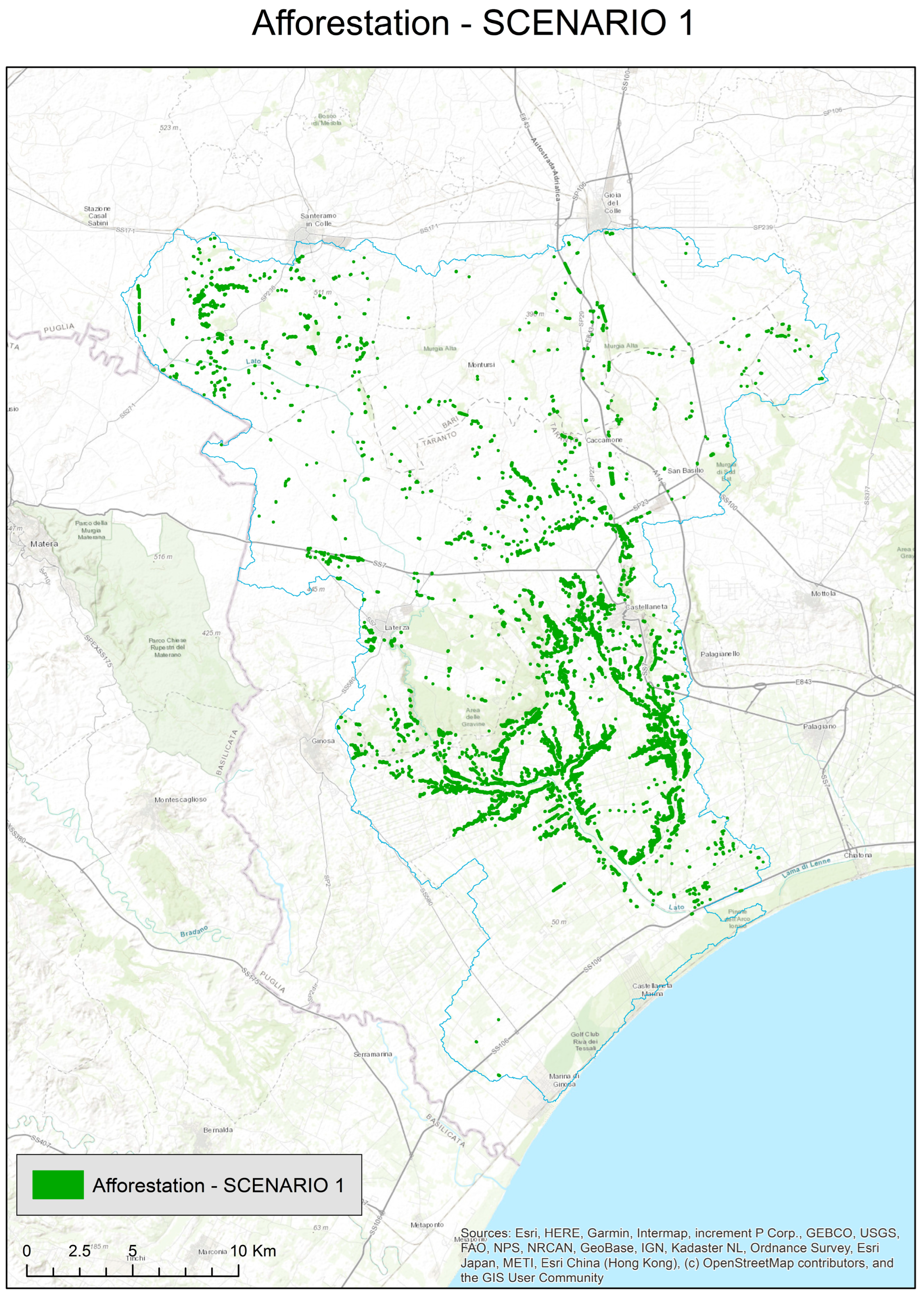
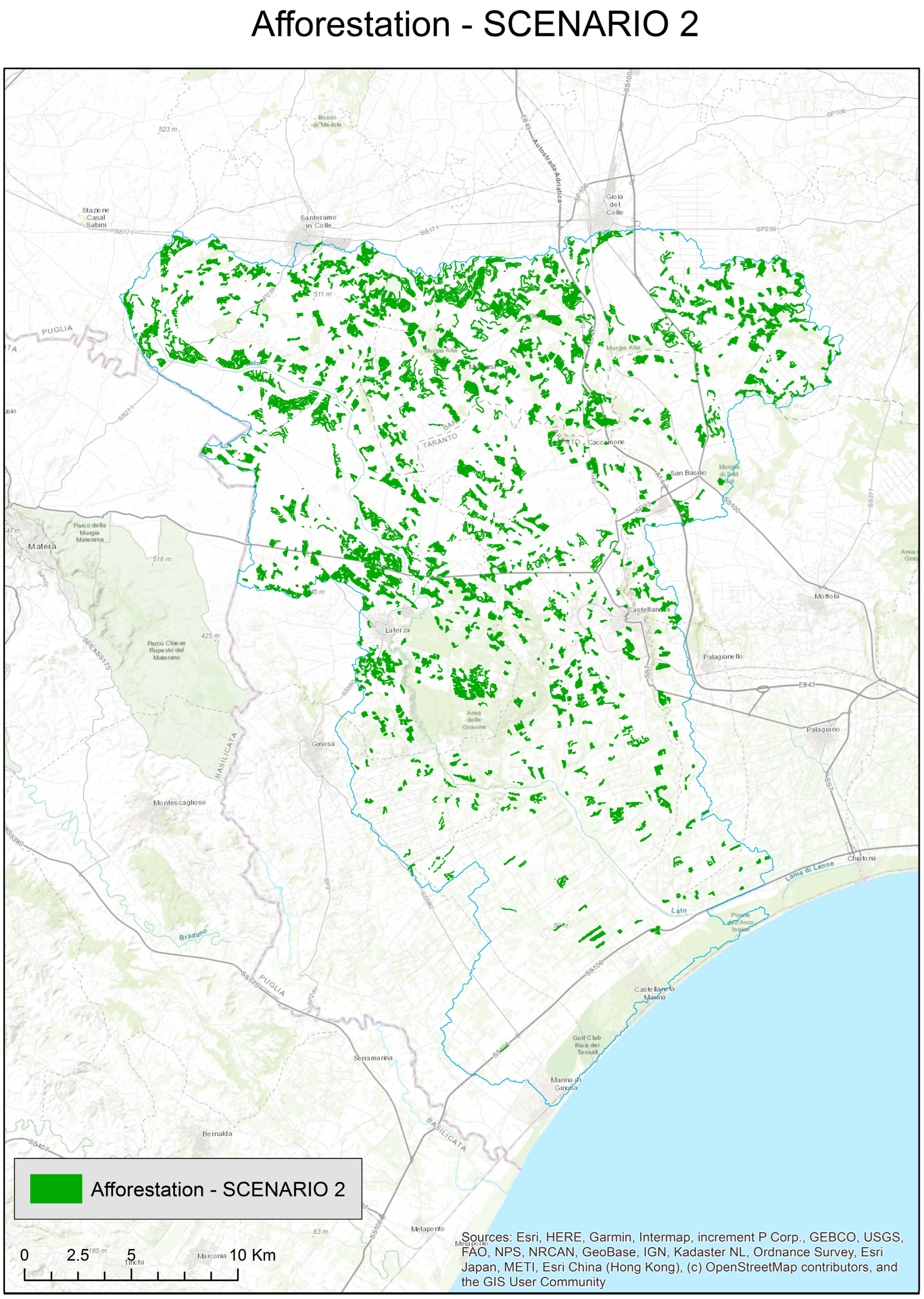
| SCENARIO | MIN | MAX | RANGE | MEAN | STD | SUM | Valore Ha | |
|---|---|---|---|---|---|---|---|---|
| 0 | Erosion | 0.00 | 62.89 | 62.89 | 1.02 | 1.72 | 11,037,428.40 | |
| Habitat (no.) | 0.00 | 4.00 | 4.00 | 2.00 | 1.01 | 22,789,879.00 | ||
| Habitat (EUR) | 0.00 | 7313.83 | 7313.83 | 1663.06 | 1146.78 | 18,862,661,079.00 | 1662.45 | |
| Carbon (Mg/ha) | 0.06 | 38.19 | 38.13 | 8.38 | 11.39 | 95,099,511.40 | ||
| CO2 (ton) | 0.23 | 139.78 | 139.56 | 30.68 | 41.70 | 348,064,211.72 | ||
| Carbon (EUR/ton) | 15.79 | 9747.05 | 9731.26 | 2139.31 | 2907.68 | 24,270,517,483.54 | 2139.06 | |
| Tourism value (no.) | 0.00 | 4.14 | 4.14 | 0.80 | 0.76 | 9,120,989.29 | ||
| Tourism value (no./ha) | 0.00 | 0.027 | 0.027 | 0.005 | 0.005 | 58,374.33 | ||
| Tourism value (EUR/ha) | 0.00 | 10.69 | 10.69 | 2.08 | 1.95 | 23,547,621.57 | 324.27 | |
| Productivity (EUR/ha) | 0.00 | 24,564.80 | 24,564.80 | 5612.93 | 8438.94 | 63,679,685,688.18 | 5612.36 | |
| 1 | Erosion | 0.00 | 10.00 | 10.00 | 0.84 | 1.30 | 9,113,727.28 | |
| Habitat (no.) | 0.00 | 4.00 | 4.00 | 2.05 | 1.01 | 23,304,160.00 | ||
| Habitat (EUR) | 34.64 | 7313.83 | 7313.83 | 1757.90 | 1180.08 | 19,939,154,841.03 | 1757.32 | |
| Carbon (Mg/ha) | 0.06 | 38.19 | 38.13 | 9.19 | 11.77 | 104,282,348.17 | ||
| CO2 (ton) | 0.23 | 139.78 | 139.56 | 33.64 | 43.08 | 381,673,394.30 | ||
| Carbon (EUR/ton) | 15.79 | 9747.05 | 9731.26 | 2345.87 | 3004.09 | 26,614,085,783.97 | 2345.61 | |
| Tourism value (no.) | 0.00 | 4.14 | 4.14 | 0.84 | 0.77 | 9,562,061.29 | ||
| Tourism value (no./ha) | 0.00 | 0.03 | 0.03 | 0.01 | 0.00 | 61,197.19 | ||
| Tourism value (EUR/ha) | 0.00 | 10.69 | 10.69 | 2.18 | 1.99 | 24,686,335.38 | 339.95 | |
| Productivity (EUR/ha) | 0.00 | 24,564.80 | 24,564.80 | 5384.19 | 8333.31 | 61,084,878,858.41 | 5383.67 | |
| 2 | Erosion | 0.00 | 62.89 | 62.89 | 0.88 | 1.65 | 9,443,885.25 | |
| Habitat (no.) | 0.00 | 4.00 | 4.00 | 2.06 | 1.03 | 233,674,67.00 | ||
| Habitat (EUR) | 0.00 | 7313.83 | 7313.83 | 1674.20 | 1140.55 | 18,988,943,104.67 | 1673.58 | |
| Carbon (Mg/ha) | 0.06 | 38.19 | 38.13 | 9.50 | 11.87 | 107,750,405.6 | ||
| CO2 (ton) | 0.23 | 139.78 | 139.56 | 34.76 | 43.44 | 394,366,484.40 | ||
| Carbon (EUR/ton) | 15.79 | 9747.05 | 9731.26 | 2423.88 | 3029.02 | 27,499,174,957.07 | 2423.62 | |
| Tourism value (no.) | 0.00 | 4.14 | 4.14 | 0.85 | 0.78 | 9,673,038.56 | ||
| Tourism value (no./ha) | 0.00 | 0.03 | 0.03 | 0.01 | 0.01 | 61,907.45 | ||
| Tourism value (EUR/ha) | 0.00 | 10.69 | 10.69 | 2.20 | 2.02 | 24,972,844.97 | 343.90 | |
| Productivity (EUR/ha) | 0.00 | 24,564.80 | 24,564.80 | 5493.09 | 8451.72 | 62,320,593,389.90 | 5492.58 |


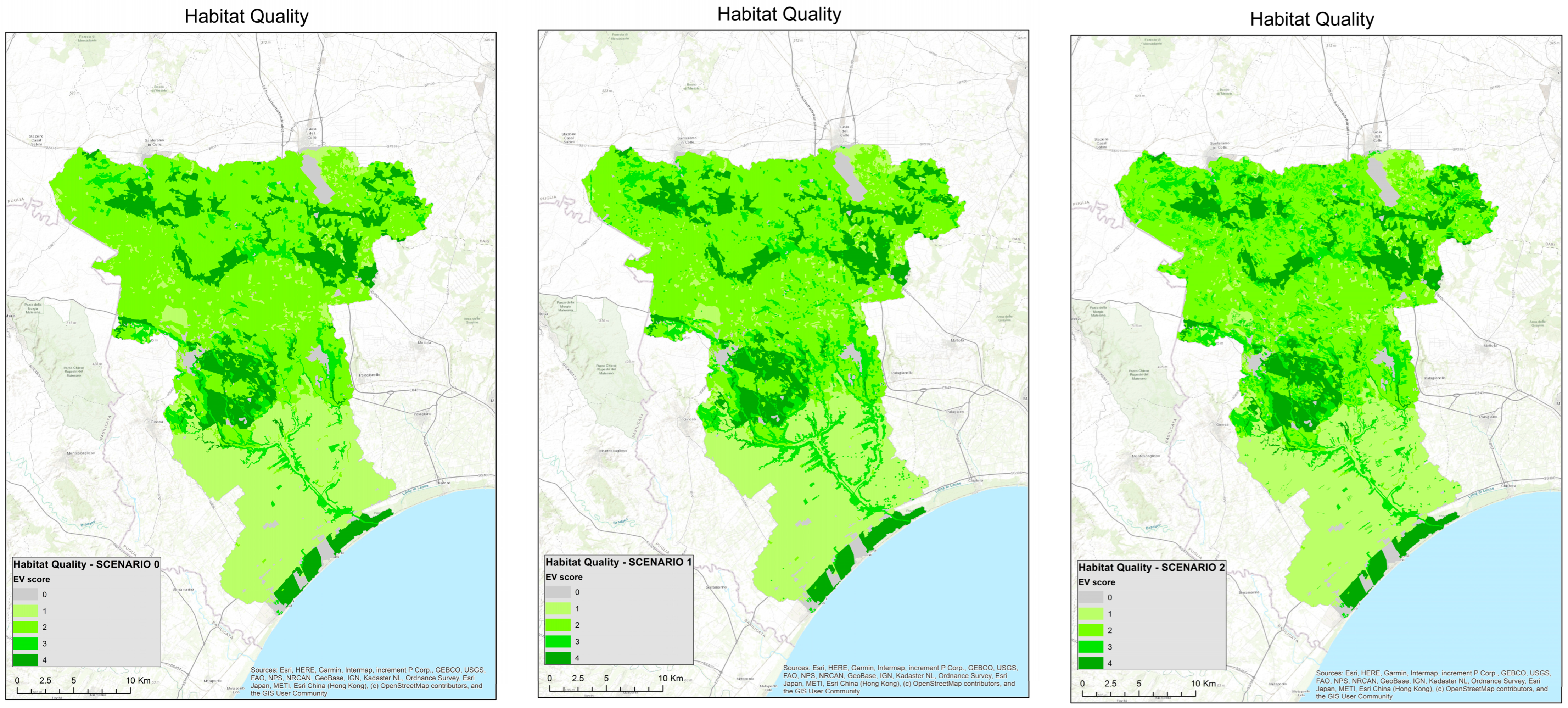

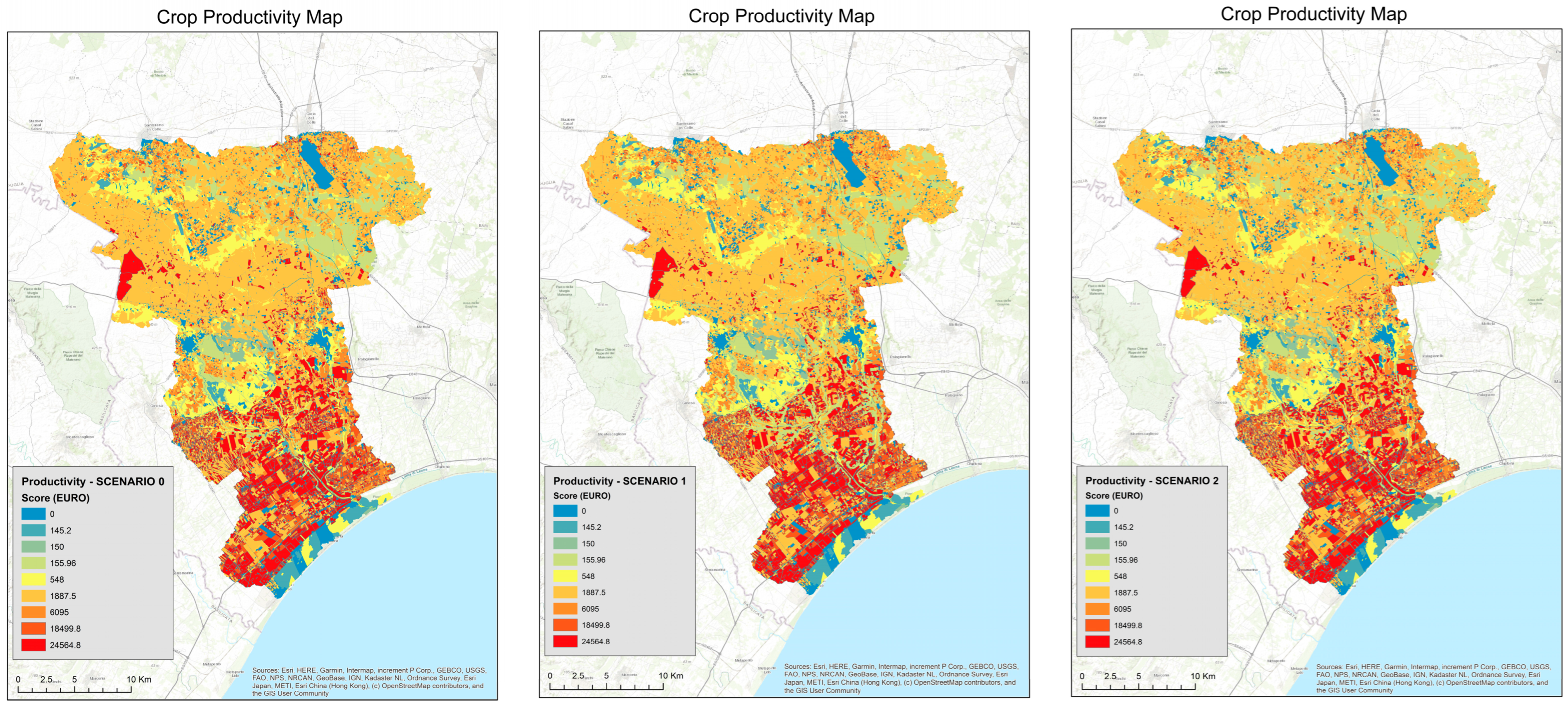
| Land Use Classes (Corine 2012) | Carbon (Ton/ha) | Conversion into Euros of CO2 (EUR/ton/ha) | Monetary Revaluation of Habitat Quality 2007 > 2015 (EUR/ha) | Agric. and Forestry Production Before Afforestation (EUR/ha) | Agric and Forestry Production After Afforestation (EUR/ha) | Sustainable Tourism Suitability (EUR/ha) | Increase in S.E. (EUR/ha) × 12 years | Decrease in S.E. (EUR/ha) × 12 years | Economic Advantage (EUR/ha) × 12 years | Replacement Cost | Costs Authorized by PSR Puglia (EUR/ha) | Lost Income (EUR/ha) | Lost Income for 12 Years (EUR/ha) | Maintenance (EUR/ha) | Total Cost (EUR/ha) (1) | Financial Convenience (EUR/ha) |
|---|---|---|---|---|---|---|---|---|---|---|---|---|---|---|---|---|
| Vineyards | 25.80 | 6584.46 | 1806.83 | 24,564.83 | 155.96 | 601.05 | 37,350.56 | 294,777.96 | −257,427.40 | 18,192.00 | 10,500.00 | 950.00 | 11,400.00 | 34,154.40 | 56,054.40 | −201,373.00 |
| Olive groves | 25.80 | 6584.46 | 1806.83 | 6095.00 | 155.96 | 645.42 | 37,883.03 | 73,140.00 | −35,256.97 | 18,192.00 | 10,500.00 | 550.00 | 6600.00 | 34,154.40 | 51,254.40 | 15,997.43 |
| Orchards and minor fruits | 25.80 | 6584.46 | 1806.83 | 18,499.75 | 155.96 | 504.24 | 36,188.79 | 221,997.00 | −185,808.21 | 18,192.00 | 10,500.00 | 950.00 | 11,400.00 | 34,154.40 | 56,054.40 | −129,753.81 |
| Vegetable gardens and seasonal crops | 25.80 | 6584.46 | 1806.83 | 29,324.25 | 155.96 | 471.97 | 35,801.54 | 351,891.00 | −316,089.46 | 18,192.00 | 10,500.00 | 700.00 | 8400.00 | 34,154.40 | 53,054.40 | −263,035.06 |
| Non-irrigated arable crops | 25.80 | 6584.46 | 1806.83 | 1887.50 | 155.96 | 665.59 | 38,125.07 | 22,650.00 | 15,475.07 | 18,192.00 | 10,500.00 | 400.00 | 4800.00 | 34,154.40 | 49,454.40 | 33,979.33 |
| Wooded areas | 25.80 | 6584.46 | 1806.83 | 155.96 | 155.96 | 693.83 | 38,463.91 | 1871.52 | 36,592.39 | 0.00 | 0.00 | 0.00 | 0.00 | 0.00 | 0.00 | 36,592.39 |
| Natural pasture areas and meadows | 25.80 | 6584.46 | 1806.83 | 0.00 | 155.96 | 722.07 | 38,802.76 | 0.00 | 38,802.76 | 0.00 | 0.00 | 0.00 | 0.00 | 0.00 | 0.00 | 38,802.76 |
| Shrubs and scrub | 25.80 | 6584.46 | 1806.83 | 0.00 | 155.96 | 689.80 | 38,415.51 | 0.00 | 38,415.51 | 0.00 | 0.00 | 0.00 | 0.00 | 0.00 | 0.00 | 38,415.51 |
References
- Young, I.M.; Crawford, J.W. Interactions and Self-Organization in the Soil-Microbe Complex. Science 2004, 304, 1634–1637. [Google Scholar] [CrossRef] [PubMed]
- Greenland, D.J.; Szabolcs, I. Soil Resilience and Sustainable Land Use; CAB International: Wallingford, CT, USA, 1994; ISBN 978-0-85198-871-9. [Google Scholar]
- Amundson, R.; Berhe, A.A.; Hopmans, J.W.; Olson, C.; Sztein, A.E.; Sparks, D.L. Soil and Human Security in the 21st Century. Science 2015, 348, 1261071. [Google Scholar] [CrossRef]
- Robinson, D.A.; Panagos, P.; Borrelli, P.; Jones, A.; Montanarella, L.; Tye, A.; Obst, C.G. Soil Natural Capital in Europe; a Framework for State and Change Assessment. Sci. Rep. 2017, 7, 6706. [Google Scholar] [CrossRef] [PubMed]
- FAO. The Status of the World’s Soil Resources (SWSR)—Main Report Food and Agriculture Organization of the United Nations and Intergovernmental Technical Panel on Soils; FAO and ITPS: Rome, Italy, 2015. [Google Scholar]
- Borrelli, P.; Robinson, D.A.; Fleischer, L.R.; Lugato, E.; Ballabio, C.; Alewell, C.; Meusburger, K.; Modugno, S.; Schütt, B.; Ferro, V.; et al. An Assessment of the Global Impact of 21st Century Land Use Change on Soil Erosion. Nat. Commun. 2017, 8, 2013. [Google Scholar] [CrossRef]
- van den Born, G.J.; De Haan, B.J.; Pearce, D.W.; Howarth, A. Technical Report on Soil Degradation in Europe: An Integrated Economic and Environmental Assessment; RIVM, EFTEC, NTUA and IIASA in association with TME and TNO under contract with the Environment Directorate-General of the European Commission; PBL Netherlands Environmental Assessment Agency: The Hague, The Netherlands, 2000. [Google Scholar]
- Romanazzi, G.R.; Ottomano Palmisano, G.; Cioffi, M.; Leronni, V.; Toromani, E.; Koto, R.; De Boni, A.; Acciani, C.; Roma, R. A Cost–Benefit Analysis for the Economic Evaluation of Ecosystem Services Lost Due to Erosion in a Mediterranean River Basin. Land 2024, 13, 1512. [Google Scholar] [CrossRef]
- López-Vicente, M.; Sun, X.; Onda, Y.; Kato, H.; Gomi, T.; Hiraoka, M. Effect of Tree Thinning and Skidding Trails on Hydrological Connectivity in Two Japanese Forest Catchments. Geomorphology 2017, 292, 104–114. [Google Scholar] [CrossRef]
- Costanza, R.; d’Arge, R.; De Groot, R.; Farber, S.; Grasso, M.; Hannon, B.; Limburg, K.; Naeem, S.; O’Neill, R.V.; Paruelo, J.; et al. The Value of the World’s Ecosystem Services and Natural Capital. Nature 1997, 387, 253–260. [Google Scholar] [CrossRef]
- Millennium Ecosystem Assessment (Program) (Ed.) Ecosystems and Human Well-Being; Island Press: Washington, DC, USA, 2005; ISBN 978-1-59726-040-4. [Google Scholar]
- Barrios, E. Soil Biota, Ecosystem Services and Land Productivity. Ecol. Econ. 2007, 64, 269–285. [Google Scholar] [CrossRef]
- Williams, A.; Hedlund, K. Indicators of Soil Ecosystem Services in Conventional and Organic Arable Fields along a Gradient of Landscape Heterogeneity in Southern Sweden. Appl. Soil Ecol. 2013, 65, 1–7. [Google Scholar] [CrossRef]
- Adhikari, K.; Hartemink, A.E. Linking Soils to Ecosystem Services—A Global Review. Geoderma 2016, 262, 101–111. [Google Scholar] [CrossRef]
- Deng, S.; Shi, Y.; Jin, Y.; Wang, L. A GIS-Based Approach for Quantifying and Mapping Carbon Sink and Stock Values of Forest Ecosystem: A Case Study. Energy Procedia 2011, 5, 1535–1545. [Google Scholar] [CrossRef]
- Trabucchi, M.; O’Farrell, P.J.; Notivol, E.; Comín, F.A. Mapping Ecological Processes and Ecosystem Services for Prioritizing Restoration Efforts in a Semi-Arid Mediterranean River Basin. Environ. Manag. 2014, 53, 1132–1145. [Google Scholar] [CrossRef] [PubMed]
- Plieninger, T.; Dijks, S.; Oteros-Rozas, E.; Bieling, C. Assessing, Mapping, and Quantifying Cultural Ecosystem Services at Community Level. Land Use Policy 2013, 33, 118–129. [Google Scholar] [CrossRef]
- Seppelt, R.; Dormann, C.F.; Eppink, F.V.; Lautenbach, S.; Schmidt, S. A Quantitative Review of Ecosystem Service Studies: Approaches, Shortcomings and the Road Ahead: Priorities for Ecosystem Service Studies. J. Appl. Ecol. 2011, 48, 630–636. [Google Scholar] [CrossRef]
- Vrebos, D.; Staes, J.; Vandenbroucke, T.; D’Haeyer, T.; Johnston, R.; Muhumuza, M.; Kasabeke, C.; Meire, P. Mapping Ecosystem Service Flows with Land Cover Scoring Maps for Data-Scarce Regions. Ecosyst. Serv. 2015, 13, 28–40. [Google Scholar] [CrossRef]
- De Groot, R.S.; Wilson, M.A.; Boumans, R.M.J. A Typology for the Classification, Description and Valuation of Ecosystem Functions, Goods and Services. Ecol. Econ. 2002, 41, 393–408. [Google Scholar] [CrossRef]
- Kumar, P. (Ed.) The Economics of Ecosystems and Biodiversity: Ecological and Economic Foundations; Routledge: London, UK, 2012; ISBN 978-1-136-53880-3. [Google Scholar]
- Kareiva, P.; Tallis, H.; Ricketts, T.H.; Daily, G.C.; Polasky, S. (Eds.) Natural Capital: Theory and Practice of Mapping Ecosystem Services; Oxford University Press: Oxford, UK, 2011; ISBN 978-0-19-958899-2. [Google Scholar]
- Pereira, P.; Brevik, E.C.; Muñoz-Rojas, M.; Miller, B.A. (Eds.) Soil Mapping and Process Modeling for Sustainable Land Use Management; Elsevier: Amsterdam, The Netherlands, 2017; ISBN 978-0-12-805200-6. [Google Scholar]
- Steinhoff-Knopp, B.; Kuhn, T.K.; Burkhard, B. The Impact of Soil Erosion on Soil-Related Ecosystem Services: Development and Testing a Scenario-Based Assessment Approach. Environ. Monit. Assess. 2021, 193, 274. [Google Scholar] [CrossRef]
- Sartori, M.; Philippidis, G.; Ferrari, E.; Borrelli, P.; Lugato, E.; Montanarella, L.; Panagos, P. A Linkage between the Biophysical and the Economic: Assessing the Global Market Impacts of Soil Erosion. Land Use Policy 2019, 86, 299–312. [Google Scholar] [CrossRef]
- Economic Research Service. European Union—Common Agricultural Policy. Available online: https://www.ers.usda.gov/topics/international-markets-us-trade/countries-regions/european-union/common-agricultural-policy (accessed on 8 September 2025).
- Panagos, P.; Katsoyiannis, A. Soil Erosion Modelling: The New Challenges as the Result of Policy Developments in Europe. Environ. Res. 2019, 172, 470–474. [Google Scholar] [CrossRef]
- European Commission. Soil Strategy for 2030. Available online: https://environment.ec.europa.eu/topics/soil-health/soil-strategy-2030_en (accessed on 7 August 2025).
- McBratney, A.; Field, D.J.; Koch, A. The Dimensions of Soil Security. Geoderma 2014, 213, 203–213. [Google Scholar] [CrossRef]
- Robinson, D.A.; Fraser, I.; Dominati, E.J.; Davíðsdóttir, B.; Jónsson, J.O.G.; Jones, L.; Jones, S.B.; Tuller, M.; Lebron, I.; Bristow, K.L.; et al. On the Value of Soil Resources in the Context of Natural Capital and Ecosystem Service Delivery. Soil. Sci. Soc. Am. J. 2014, 78, 685–700. [Google Scholar] [CrossRef]
- García-Ruiz, J.M. The Effects of Land Uses on Soil Erosion in Spain: A Review. Catena 2010, 81, 1–11. [Google Scholar] [CrossRef]
- Chen, Y.; Wang, K.; Lin, Y.; Shi, W.; Song, Y.; He, X. Balancing Green and Grain Trade. Nat. Geosci. 2015, 8, 739–741. [Google Scholar] [CrossRef]
- Liu, Y.-F.; Liu, Y.; Shi, Z.-H.; López-Vicente, M.; Wu, G.-L. Effectiveness of Re-Vegetated Forest and Grassland on Soil Erosion Control in the Semi-Arid Loess Plateau. Catena 2020, 195, 104787. [Google Scholar] [CrossRef]
- Amoruso, A.; Luisi, N.; Sanesi, G. Prime valutazioni su alcuni impianti di arboricoltura realizzati in Pugllia nell’ambito della campagnia 1994/96 del Reg. CEE 2080/92. L’Italia For. Mont. 2005, 3, 293–316. [Google Scholar]
- Bando Sottomisura 8.1—2022—PSR Puglia. Available online: https://psr.regione.puglia.it/bando-sottomisura-8.1-2022 (accessed on 7 August 2025).
- Avviso Pubblico per La Presentazione Di Proposte Di Intervento Di Forestazione Urbana, Periurbana Ed Extraurbana Nelle Città Metropolitane—Annualità 2023/2024. Available online: https://www.mase.gov.it/portale/-/avviso-pubblico-per-la-presentazione-di-proposte-di-intervento-di-forestazione-urbana-periurbana-ed-extraurbana-nelle-citta-metropolitane-annualita-2023-2024 (accessed on 8 September 2025).
- InVEST | Natural Capital Project. Available online: https://naturalcapitalproject.stanford.edu/software/invest (accessed on 7 August 2025).
- Sharp, R.; Chaplin-Kramer, R.; Wood, S.; Guerry, A.; Tallis, H.; Ricketts, T.; Nelson, E.; Ennaanay, D.; Wolny, S.; Olwero, N.; et al. InVEST User’s Guide; The Natural Capital Project; Stanford University: Stanford, CA, USA; University of Minnesota: Minneapolis, MN, USA; The Nature Conservancy: Arlington, VA, USA; World Wildlife Fund: Washington, DC, USA, 2018. [Google Scholar]
- Caliandro, A.; Lamaddalena, N.; Stelluti, M.; Steduto, P. Riorientamenti Produttivi Del Territorio Agricolo Pugliese per Uno Sviluppo Rurale Sostenibile; CIHEAM: Bari, Italy, 2005; ISBN 2-85352-395-0. [Google Scholar]
- Bagarello, V.; Ferro, V. Erosione e Conservazione Del Suolo; McGraw-Hill: Milano, Italy, 2006; ISBN 88-386-6311-4. [Google Scholar]
- Valutazione Ex-Post—PSR 2007–2013 Puglia. Available online: https://www.reterurale.it/flex/cm/pages/ServeBLOB.php/L/IT/IDPagina/24783 (accessed on 8 September 2025).
- Direttiva—92/43—IT—EUR-Lex. Available online: https://eur-lex.europa.eu/eli/dir/1992/43/oj/ita (accessed on 15 September 2025).
- Piano Assetto Idrogeologico—Pericolosità Idraulica. Available online: https://www.distrettoappenninomeridionale.it/oldsite/index.php/elaborati-di-piano-menu/ex-adb-puglia-menu/piano-assetto-idrogeologico-pericolosita-idraulica-menu (accessed on 8 September 2025).
- Gazzetta Ufficiale. Available online: https://www.gazzettaufficiale.it/dettaglio/codici/materiaAmbientale (accessed on 8 September 2025).
- Vigiak, O.; Borselli, L.; Newham, L.T.H.; McInnes, J.; Roberts, A.M. Comparison of Conceptual Landscape Metrics to Define Hillslope-Scale Sediment Delivery Ratio. Geomorphology 2012, 138, 74–88. [Google Scholar] [CrossRef]
- Gasperini, P.; Di Cosmo, L.; Pompei, E. Il Contenuto Di Carbonio Delle Foreste Italiane. Inventario Nazionale Delle Foreste e Dei Serbatoi Forestali Di Carbonio; CREA: Rome, Italy, 2013; ISBN 978-88-97081-36-4. [Google Scholar]
- Iglesias, D.J.; Quiñones, A.; Font, A.; Martínez-Alcántara, B.; Forner-Giner, M.Á.; Legaz, F.; Primo-Millo, E. Carbon Balance of Citrus Plantations in Eastern Spain. Agric. Ecosyst. Environ. 2013, 171, 103–111. [Google Scholar] [CrossRef]
- Proietti, S.; Sdringola, P.; Desideri, U.; Zepparelli, F.; Brunori, A.; Ilarioni, L.; Nasini, L.; Regni, L.; Proietti, P. Carbon Footprint of an Olive Tree Grove. Appl. Energy 2014, 127, 115–124. [Google Scholar] [CrossRef]
- ISO 14235:1998; Soil Quality—Determination of Organic Carbon by Sulfochromic Oxidation. ISO: Geneva, Switzerland, 1998. Available online: https://www.iso.org/standard/23140.html (accessed on 25 July 2025).
- Prezzi CO2—Sendeco2. Available online: https://www.sendeco2.com/it/prezzi-co2 (accessed on 25 July 2025).
- Investing.Com—Stock Market Quotes & Financial News. Available online: https://www.investing.com/ (accessed on 25 July 2025).
- Carta Della Natura. Available online: https://www.isprambiente.gov.it/it/servizi/sistema-carta-della-natura (accessed on 7 August 2025).
- Costanza, R.; De Groot, R.; Sutton, P.; Van Der Ploeg, S.; Anderson, S.J.; Kubiszewski, I.; Farber, S.; Turner, R.K. Changes in the Global Value of Ecosystem Services. Glob. Environ. Change 2014, 26, 152–158. [Google Scholar] [CrossRef]
- Purchasing Power Parities (PPP). Available online: https://www.oecd.org/en/data/indicators/purchasing-power-parities-ppp.html (accessed on 25 July 2025).
- Istat—Rivaluta. Available online: https://rivaluta.istat.it/ (accessed on 25 July 2025).
- Carta Tipi Forestali. Available online: https://webapps.sit.puglia.it/freewebapps/CartaTipiForestali/index.html (accessed on 25 July 2025).
- Il Turismo in Puglia—Osservatorio. Available online: https://osservatorio.dms.puglia.it/knowage-vue/document-composite/Homepage_public (accessed on 28 July 2025).
- ARET—Agenzia Regionale Del Turismo Pugliapromozione—Liferay. Available online: https://aret.regione.puglia.it/ (accessed on 28 July 2025).
- Elenco Prezzi Opere Pubbliche. Available online: https://www.regione.puglia.it/web/territo-rio-mobilita-e-infrastrutture/elenco-prezzi-opere-pubbliche (accessed on 25 July 2025).
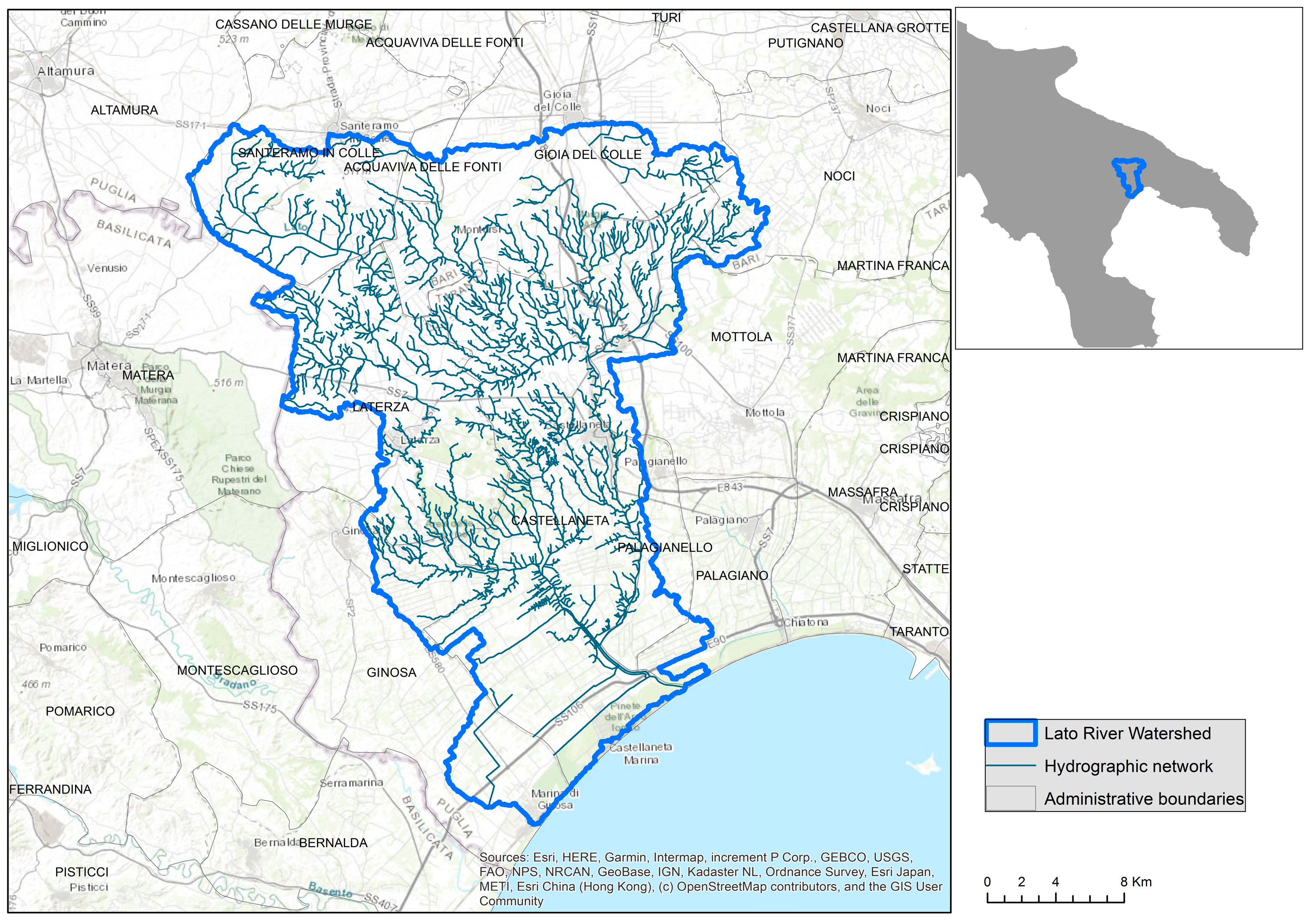
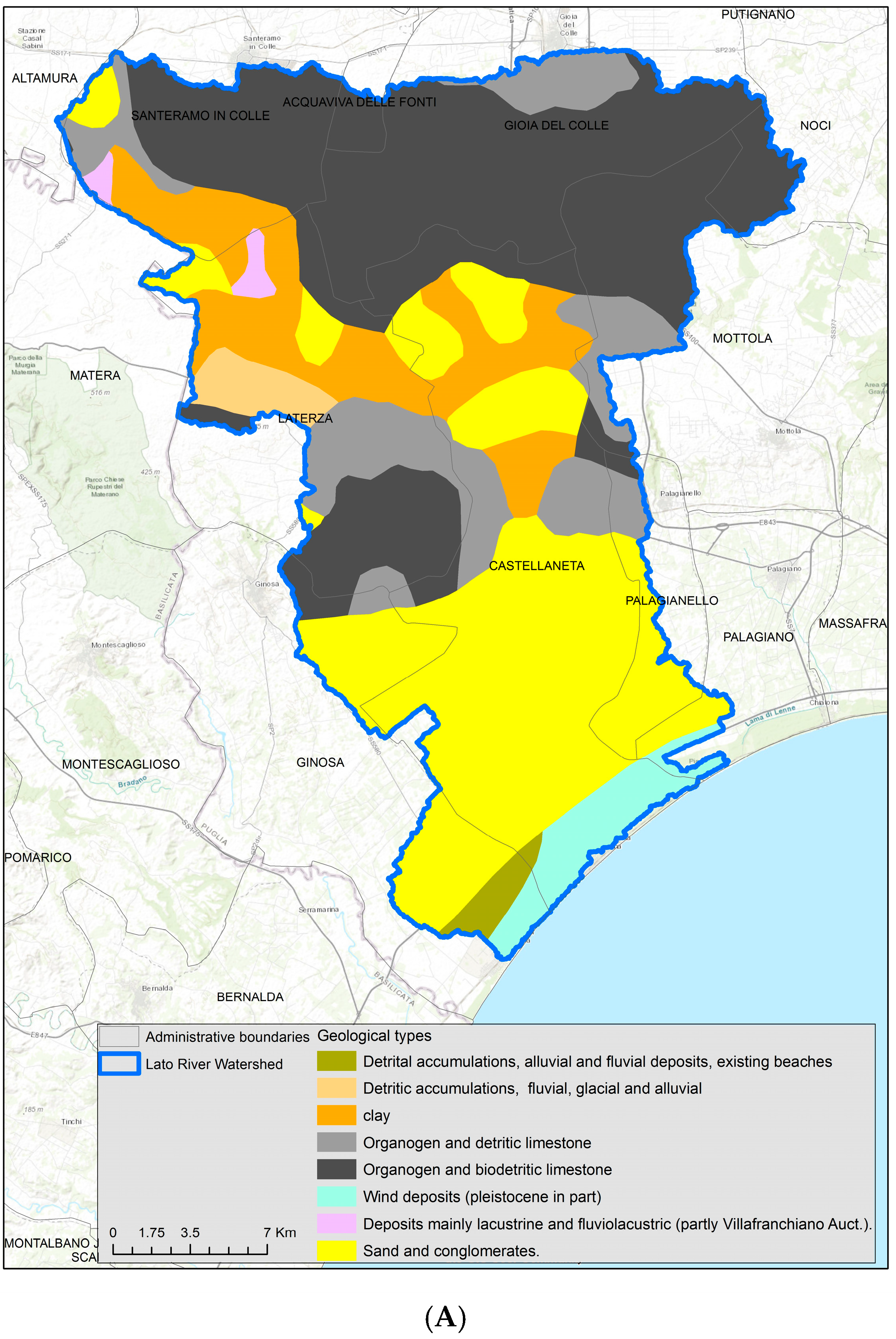
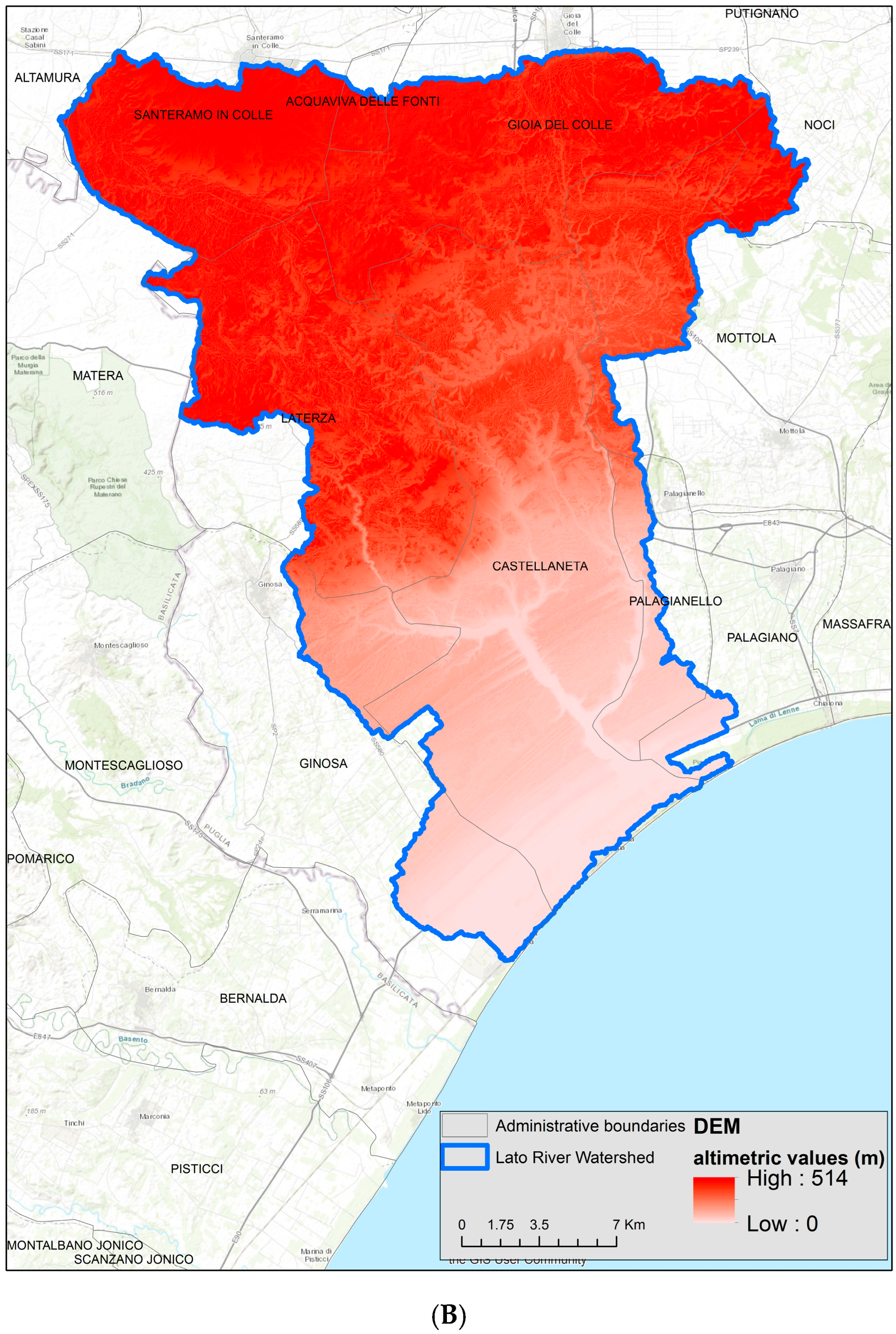
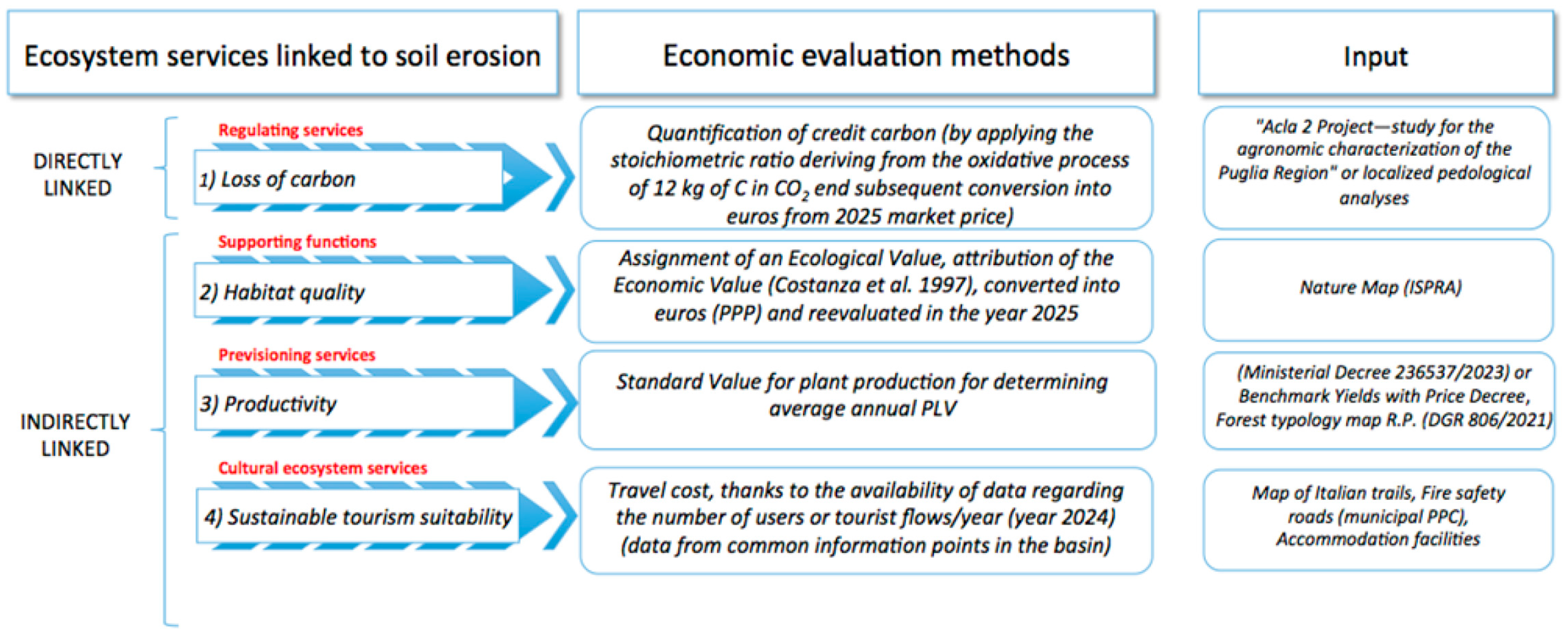
| Municipality | Area (km2) |
|---|---|
| Castellaneta | 243.3 |
| Laterza | 126.8 |
| Gioia del Colle | 119.9 |
| Santeramo in Colle | 81.3 |
| Ginosa | 55.6 |
| Mottola | 54.1 |
| Palagianello | 24.6 |
| Noci | 13.6 |
| Palagiano | 8.7 |
| Acquaviva delle Fonti | 7.0 |
| Altamura | 0.2 |
| Economic Productivity | Land Use | SCENARIO 1 | SCENARIO 2 | ||
|---|---|---|---|---|---|
| ha | % | ha | % | ||
| High | Vineyards | 460.45 | 13.16 | 0 | 0 |
| Olive groves | 339.58 | 9.70 | 0 | 0 | |
| Orchards and minor fruits | 60.86 | 1.74 | 0 | 0 | |
| Simple arable crops in irrigated areas (vegetable gardens) | 92.53 | 2.64 | 0 | 0 | |
| Medium | Simple arable land in non-irrigated areas | 1450.97 | 41.46 | 3500 | 100 |
| Other crops | 14.21 | 0.41 | 0 | 0 | |
| Low (natural areas) | Wooded areas | 393.30 | 11.24 | 0 | 0 |
| Natural pasture areas and meadows | 210.13 | 5.75 | 0 | 0 | |
| Shrubs | 319.48 | 9.13 | 0 | 0 | |
| Surface water | 17.74 | 0.51 | 0 | 0 | |
| Other uses | 149.76 | 4.28 | 0 | 0 | |
| Total | 3500 | 100.00 | 3500 | 100.00 | |
| Type of Land Use and Relative Converted Economic Value (EUR/ha/year 2007, Updated to April 2025) | ||||||
|---|---|---|---|---|---|---|
| Value | Habitat Value | Coniferous and Deciduous Forests | Pastures and Scrubs | Agricultural Crops | Coastal Systems | Rivers and Lakes |
| 0 | Null | 0 | 0 | 0 | 0 | 0 |
| 1 | Low | 1294.56 | 116.92 | 788.24 | 24.67 | 1363.39 |
| 2 | Medium | 1550.70 | 1941.68 | 1576.48 | 29.65 | 3346.43 |
| 3 | High | 1806.84 | 3766.44 | 2364.71 | 34.64 | 5330.22 |
| 4 | Very high | 2062.00 | 5591.21 | 3152.95 | 39.67 | 7313.83 |
| Agricultural Crop | Standard Value EUR/ha/year |
|---|---|
| Wine vine | 14,755.66 |
| Table vine | 34,374.00 |
| Olive | 6095.00 |
| Cherry tree | 14,700.00 |
| Peaches | 33,649.00 |
| Almonds | 11,453.00 |
| Wheat (average between hard and soft) | 2260.00 |
| Legumes (average between lentils and chickpeas) | 1877.50 |
| Pasture | 326.00 |
| Pasture meadow | 770.00 |
| Legume and grass crops (average) | 1362.50 |
| Trifoglio | 2050.00 |
| Mandarances (average between late and early) | 14,197.00 |
| Vegetables (average among melons, radish, celery and spinach) | 29,324.25 |
| Forest Types (1) | Pinus Halepensis Forests | Plantations of Other Broadleaf Trees (Eucalyptus) | Quercus Ilex and Fraxinus Ornus Forests | Other Evergreen Broadleaf Forests | Carpinus sp. Forests | Oak Forests | Quercus Petrea and Q. Pubescens Forests |
|---|---|---|---|---|---|---|---|
| Corg content (Mg/ha) in above-ground biomass | 24.2 | 3.6 | 22 | 11 | 36 | 33.10 | 25 |
| Conversion to EUR | 1452 | 216 | 3080 | 1272 | 4308 | 3972 | 2964 |
| Annual value EUR | 145.20 | 21.60 | 154 | 63.60 | 215.40 | 198.60 | 148.20 |
| Territorial Elements | Standard Value EUR/ha/year |
|---|---|
| Network of paths | The network of pedestrian roads and hiking trails |
| Points of interest for accommodation and recreation | Restaurants, bars, hotels, sports facilities |
| Point of cultural interest | Cultural element and historical–cultural elements, archaeological areas |
| Natural protected areas | Parks, reserves and Natura 2000 areas Woods, plantations, etc. |
| Municipality | Tourist Flows (Arrivals in 2024) | Source | Amount for Overnight Stay with Full Board (Average Value) (EUR) | Source | Percentage of Municipal Surface Area Falling within the Basin | Tourist Flow (Number of Visitors) | Average Service Value (EUR) |
|---|---|---|---|---|---|---|---|
| Castellaneta | 57,701 | BIT Milano | 372 | Puglia promozione | 100.00% | 57,701 | 21,464,772.00 |
| Ginosa | 26,760 | BIT Milano | 225 | 84.00% | 22,478.4 | 5,057,640.00 | |
| Gioia del Colle | 16,901 | Pugliapromozione | 103.71 | 74.37% | 12,569.27 | 1,303,559.38 | |
| Laterza | 4319 | Oasi Lipu Laterza | 84 | 100.00% | 4319 | 362,796.00 | |
| Mottola | 8169 | Pugliapromozione | 123 | 18.57% | 1516.98 | 186,588.95 | |
| Noci | 15,127 | 130 | 20.90% | 3161.54 | 411,000.59 | ||
| Palagianello | 1094 | 110 | 45.21% | 494.60 | 54,405.71 | ||
| Santeramo in Colle | 6836 | 120 | 55.14% | 3769.37 | 452,324.45 | ||
| Total | 136,907 | 158.464 | 106,010.17 | 29,293,087.07 |
| EROSION (t/ha/year) | ||||||
|---|---|---|---|---|---|---|
| Scenario | Min | Max | Range | Mean | Std | Sum |
| 0 | 0.00 | 62.89 | 62.89 | 1.02 | 1.72 | 11,037,428.40 |
| 1 | 0.00 | 10.00 | 10.00 | 0.84 | 1.30 | 9,113,727.28 |
| 2 | 0.00 | 62.89 | 62.89 | 0.88 | 1.65 | 9,443,885.25 |
| Habitat | |||||||
|---|---|---|---|---|---|---|---|
| Scenario | Min | Max | Range | Mean | Std | Sum | |
| 0 | no. | 0.00 | 4.00 | 4.00 | 2.00 | 1.01 | 22,789,879.00 |
| EUR | 0.00 | 7313.83 | 7313.83 | 1663.06 | 1146.78 | 18,862,661,079.00 | |
| 1 | no. | 0.00 | 4.00 | 4.00 | 2.05 | 1.01 | 23,304,160.00 |
| EUR | 34.64 | 7313.83 | 7313.83 | 1757.90 | 1180.08 | 19,939,154,841.03 | |
| 2 | no. | 0.00 | 4.00 | 4.00 | 2.06 | 1.03 | 233,674,67.00 |
| EUR | 0.00 | 7313.83 | 7313.83 | 1674.20 | 1140.55 | 18,988,943,104.67 | |
| TOURISM | |||||||
|---|---|---|---|---|---|---|---|
| Scenario | Min | Max | Range | Mean | Std | Sum | |
| 0 | no. | 0.00 | 4.14 | 4.14 | 0.80 | 0.76 | 9,120,989.29 |
| no./ha | 0.00 | 0.027 | 0.027 | 0.005 | 0.005 | 58,374.33 | |
| EUR/ha | 0.00 | 10.69 | 10.69 | 2.08 | 1.95 | 23,547,621.57 | |
| 1 | no. | 0.00 | 4.14 | 4.14 | 0.84 | 0.77 | 9,562,061.29 |
| no./ha | 0.00 | 0.03 | 0.03 | 0.01 | 0.00 | 61,197.19 | |
| EUR/ha | 0.00 | 10.69 | 10.69 | 2.18 | 1.99 | 24,686,335.38 | |
| 2 | no. | 0.00 | 4.14 | 4.14 | 0.85 | 0.78 | 9,673,038.56 |
| no./ha | 0.00 | 0.03 | 0.03 | 0.01 | 0.01 | 61,907.45 | |
| EUR/ha | 0.00 | 10.69 | 10.69 | 2.20 | 2.02 | 24,972,844.97 | |
| PRODUCTIVITY (EUR/ha) | ||||||
|---|---|---|---|---|---|---|
| Scenario | Min | Max | Range | Mean | Std | Sum |
| 0 | 0.00 | 24,564.80 | 24,564.80 | 5612.93 | 8438.94 | 63,679,685,688.18 |
| 1 | 0.00 | 24,564.80 | 24,564.80 | 5384.19 | 8333.31 | 61,084,878,858.41 |
| 2 | 0.00 | 24,564.80 | 24,564.80 | 5493.09 | 8451.72 | 62,320,593,389.90 |
Disclaimer/Publisher’s Note: The statements, opinions and data contained in all publications are solely those of the individual author(s) and contributor(s) and not of MDPI and/or the editor(s). MDPI and/or the editor(s) disclaim responsibility for any injury to people or property resulting from any ideas, methods, instructions or products referred to in the content. |
© 2025 by the authors. Licensee MDPI, Basel, Switzerland. This article is an open access article distributed under the terms and conditions of the Creative Commons Attribution (CC BY) license (https://creativecommons.org/licenses/by/4.0/).
Share and Cite
Romanazzi, G.R.; Ottomano Palmisano, G.; Cioffi, M.; Acciani, C.; De Boni, A.; Ricci, G.F.; Leronni, V.; Gentile, F.; Roma, R. Evaluation of the Economic Convenience Deriving from Reforestation Actions to Reduce Soil Erosion and Safeguard Ecosystem Services in an Apulian River Basin. Land 2025, 14, 1936. https://doi.org/10.3390/land14101936
Romanazzi GR, Ottomano Palmisano G, Cioffi M, Acciani C, De Boni A, Ricci GF, Leronni V, Gentile F, Roma R. Evaluation of the Economic Convenience Deriving from Reforestation Actions to Reduce Soil Erosion and Safeguard Ecosystem Services in an Apulian River Basin. Land. 2025; 14(10):1936. https://doi.org/10.3390/land14101936
Chicago/Turabian StyleRomanazzi, Giuliano Rocco, Giovanni Ottomano Palmisano, Marilisa Cioffi, Claudio Acciani, Annalisa De Boni, Giovanni Francesco Ricci, Vincenzo Leronni, Francesco Gentile, and Rocco Roma. 2025. "Evaluation of the Economic Convenience Deriving from Reforestation Actions to Reduce Soil Erosion and Safeguard Ecosystem Services in an Apulian River Basin" Land 14, no. 10: 1936. https://doi.org/10.3390/land14101936
APA StyleRomanazzi, G. R., Ottomano Palmisano, G., Cioffi, M., Acciani, C., De Boni, A., Ricci, G. F., Leronni, V., Gentile, F., & Roma, R. (2025). Evaluation of the Economic Convenience Deriving from Reforestation Actions to Reduce Soil Erosion and Safeguard Ecosystem Services in an Apulian River Basin. Land, 14(10), 1936. https://doi.org/10.3390/land14101936










